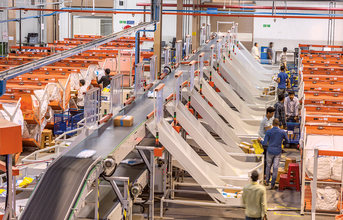
Being a part of an industry that is expected to grow four-fold in the next four years in like being on a swing only goes up. This is India's e-commerce industry. According to a May 2016 ASSOCHAM Forrester study, India's e-commerce revenue will jump from US $30 billion in 2016 to US $120 billion in 2020, growing at 51 percent per annum, the highest in the world.
Smartphone savvy millennials looking for a superior experience, competitive pricing and shopping on the move seem the surface reasons for this massive growth. However, there is something beneath the surface: warehousing costs for an e-commerce player can be as much as 25 percent of their total supply chain costs. Therefore, it is essential for e-commerce and logistics companies to automate their warehouses by deploying robotic systems to make their supply chains more effective and efficient.
With selling propositions like same-day delivery, four-hour delivery, the level of automation at warehouses becomes the key differentiator for e-commerce players. Think of a warehouse the size of a football stadium with over 10,000 different types of products. Manual sorting of shipments based on delivery destinations can be cumbersome, inaccurate, and inefficient. Instead, a robotic sorting solution can read the barcodes on the packets, and sort them according to customized parameters such as first-in first-out, delivery address, same-day delivery etc., thereby, speeding up the process almost 10 times, with higher accuracy.
Not just e-commerce and logistics, robotics will disrupt several other industries in the next few years. For instance, only about 1,000 robot-assisted surgeries were performed around the world in 2000. The number had dramatically gone up to about 5,70,000 in 2014 and is well expected to have crossed the two million mark by 2015. High precision procedures during the surgery can be handled by robots (under human supervision) to increase the chances of success of a surgery. Similarly, when you are in Japan the next time, try checking into the Henn-na hotel in a Netherlands-themed amusement park in Nagasaki. The hotel is completely staffed by multilingual robots that can process language to understand the orders and requirements of its guests and take care of them.
These examples are merely the tip of the iceberg. Robotics can do much more to reignite the global industrial growth. Here's how:
Robotic development zones
In order for an industry to flourish, it requires a conducive ecosystem. Currently, all the robo-developers work in silos, looking to source the required components, finding the right vendors, setting up manufacturing and assembly plants, and looking for the right talent to man the operations. As demand surges, we will see large industrial zones that will co-locate all these elements at one place, just like an industrial hub for automobile manufacturing. This will reduce the elementary barriers (infrastructure, talent, and choice of vendors etc.) and bring down the overall cost of development of robotics solutions.
(Continued on next page)



























